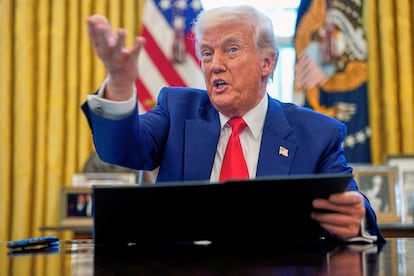How Trump’s tariffs stand after the 90-day pause
The 25% levy on steel, aluminum, and cars remain in place, as does the 10% universal rate on most imports


Donald Trump continues to wreak havoc on U.S. trade policy. The president arbitrarily imposes and removes tariffs, creating confusion and ongoing regulatory shifts. His method of announcing these changes — via social media without providing key details — along with his team’s contradictions, errors, and sudden policy shifts, keeps reshaping the tariff landscape in real-time.
On Wednesday, Trump revealed that he was raising tariffs on China to 125%. Simultaneously, under market pressure, he granted a 90-day pause on tariffs for other countries, while maintaining a 10% universal rate (with exceptions) for all nations. This is the state of U.S. trade protectionism after the latest developments.
Steel and aluminum
The widespread 25% tariffs on aluminum, steel, and related products that went into effect on March 12 remain in place. There are no changes. These tariffs affect all countries equally, including Mexico and Canada, with whom Trump signed the United States-Mexico-Canada Agreement (USMCA), which he is now violating.
Automobiles and components
Trump imposed a 25% tariff on imported passenger vehicles (sedans, SUVs, crossovers, minivans, cargo vans) and light trucks, as well as key auto parts (engines, transmissions, powertrain parts, and electrical components). The tariffs could be extended to additional parts if necessary, according to the White House. Those tariffs are not affected by the new decision. The tariffs on cars went into effect on April 3, and those on components are scheduled to begin no later than May 3.
Auto importers under the USMCA will have the opportunity to certify their U.S. content, and systems will be implemented so that the 25% tariff applies only to the value of their non-U.S. content. USMCA-compliant auto parts remain duty-free until the Secretary of Commerce, in consultation with Customs and Border Protection (CBP), establishes a process for applying tariffs to their non-U.S. content.
125% for China
Trump has made China the main target of his trade war. The U.S. president announced that he is now imposing 125% tariffs on imports from the Asian giant. Prior to Wednesday’s announcement, they were taxed at 20% on account of Washington’s claim Beijing is not doing enough to stop exports of fentanyl precursors, and reciprocal tariffs stood at 84%, for a total 104%. Trump imposed the new 125% rate as punishment for Beijing’s retaliation, which mirrored the initial 20% tariff, plus 84% for the reciprocal tariffs. Despite this, Trump remains hopeful of a potential agreement with Xi Jinping.
10% for the European Union
The pause affects the European Union, though with some nuances. The EU had a 20% reciprocal tariff on the bulk of its imports, which has now been reduced to a universal 10%. According to the White House, this is because Europe’s retaliatory counter-tariffs have not yet taken effect. On Wednesday, European countries approved retaliation for U.S. steel and aluminum tariffs, totaling $21 billion in U.S. imports.
The implementation will be staggered: on April 15, tariffs will hit a first group of imports worth $3.9 billion, followed by a $13.5 billion package a month later, and a smaller $3.5 billion blow afterward. It is unclear whether, after the first round of retaliation, Trump will raise the tariff back to 20%. The EU has yet to respond to either the car tariffs or the new 10% rate, and now faces a dilemma.

Mexico and Canada
Trump approved tariffs on his two neighboring countries, citing fentanyl and illegal immigration as justifications. Their products are subject to 25% tariffs, but products meeting USMCA requirements are exempt from this levy. These countries were excluded from the so-called “reciprocal” tariffs and are now also exempt from the universal 10% tariff.
Universal rate of 10%
Trump’s pause applies to countries previously subject to tariffs exceeding 10%. This includes Japan (24%), Vietnam (46%), Taiwan (32%), India (26%), South Korea (25%), Thailand (36%), Switzerland (31%), Indonesia (32%), as well as the 20% rate for the EU, and dozens of countries facing tariffs between 11% and 50%. These countries now face a universal 10% rate, the same as the one Trump initially set for most countries.
Steel, aluminum, and automobiles, which are already subject to the 25% tariff, are not affected by the new “reciprocal” tariffs, nor is the universal rate applicable to them. Copper, pharmaceuticals, semiconductors, and wood products are also exempt, pending their own sectoral tariffs. Critical minerals and energy are also excluded from the 10% tax.
In the list presented by Trump last week, Russia, Belarus, North Korea, and Cuba were not included, as these countries are already subject to bans, sanctions, and exclusions that prevent significant trade. However, the customs guide published on Wednesday states that the 10% tariff applies to products from “any country,” except China. By midnight, the White House had not yet released the new executive order, which will be called: “Modifying Reciprocal Tariff Rates to Reflect Trading Partner Retaliation and Alignment.”
Shopping at Shein and Temu
The United States will eliminate the so-called de minimis exemption, which allowed tariff-free shipments up to $800. This exemption for China will disappear on May 2. Imported goods with a value of $800 or less, shipped by methods other than the international postal network, will now be subject to all applicable tariffs, including the new 125% rate for China. Additionally, shipments through the international postal network with a value of $800 or less will be subject to a duty rate of 90% of their value or $75 per shipment (increasing to $150 per shipment beginning June 1, 2025), as per an executive order approved Tuesday. It remains to be seen whether this figure will increase further in line with the broader increase in tariffs on China.
Secondary tariffs for Venezuela
On March 24, Trump announced that he would impose 25% tariffs on countries that buy oil from Venezuela, starting April 2. However, the implementation was not automatic. The executive order left it to Secretary of State Marco Rubio to determine which countries would be subject to these tariffs. As of now, no tariffs have been imposed on any country. China and Spain are among the main importers of Venezuelan oil.
Exemptions for some companies?
Trump hinted on Tuesday that some companies might receive tariff exemptions during the 90-day pause period, though it remains unclear whether this would apply to Chinese imports or what the criteria for granting exemptions would be. When asked on Wednesday, he said: “We’re going to take a look at it. There are some that, by the nature of the company, get hit a little bit harder, and we’ll take a look at that.” When pressed on how he would determine which companies might receive such an exemption, Trump responded, “instinctively.” “You almost can’t take a pencil to paper. It’s really more of an instinct than anything else,” he said.
Sign up for our weekly newsletter to get more English-language news coverage from EL PAÍS USA Edition
Tu suscripción se está usando en otro dispositivo
¿Quieres añadir otro usuario a tu suscripción?
Si continúas leyendo en este dispositivo, no se podrá leer en el otro.
FlechaTu suscripción se está usando en otro dispositivo y solo puedes acceder a EL PAÍS desde un dispositivo a la vez.
Si quieres compartir tu cuenta, cambia tu suscripción a la modalidad Premium, así podrás añadir otro usuario. Cada uno accederá con su propia cuenta de email, lo que os permitirá personalizar vuestra experiencia en EL PAÍS.
¿Tienes una suscripción de empresa? Accede aquí para contratar más cuentas.
En el caso de no saber quién está usando tu cuenta, te recomendamos cambiar tu contraseña aquí.
Si decides continuar compartiendo tu cuenta, este mensaje se mostrará en tu dispositivo y en el de la otra persona que está usando tu cuenta de forma indefinida, afectando a tu experiencia de lectura. Puedes consultar aquí los términos y condiciones de la suscripción digital.
